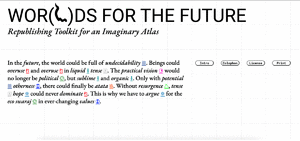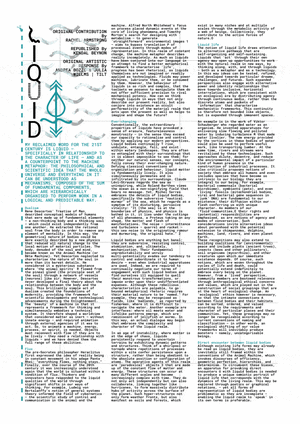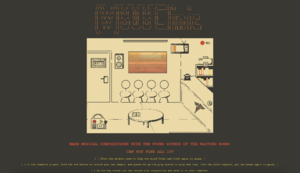User:Kendal/Final presentation: Difference between revisions
No edit summary |
No edit summary |
||
| Line 18: | Line 18: | ||
</syntaxhighlight> | </syntaxhighlight> | ||
Main focus on feedback loops, flux, flow | Main focus on feedback loops, flux, flow and text as a regenerative organism. | ||
OBSERVATION: Information inside a boundless space. | OBSERVATION: Information inside a boundless space. | ||
| Line 51: | Line 51: | ||
</syntaxhighlight> | </syntaxhighlight> | ||
=<div style="font-family: Roboto Mono;">My contribution</div>= | |||
I created a ga | |||
Non-places seem to be the absolute thing situationists want to avoid. The idea of a place so bound by rules yet devoid of humanity and play is fascinating to me because they're so easy to identify and we spend a lot of time in these places. Given this, I want to take the mundane aspects of a waiting room, and use them as ingredients to create a performative use of space in an attempt to suggest what a situationist non-place could be. | Non-places seem to be the absolute thing situationists want to avoid. The idea of a place so bound by rules yet devoid of humanity and play is fascinating to me because they're so easy to identify and we spend a lot of time in these places. Given this, I want to take the mundane aspects of a waiting room, and use them as ingredients to create a performative use of space in an attempt to suggest what a situationist non-place could be. | ||
Revision as of 15:42, 8 June 2022
Final Presentation
First Year
Special Issue · 1
URL: https://issue.xpub.nl/13/LIQUID/
Wor(l)ds for the Future
Republishing Tool Kit for an Imaginary Atlas
Words have the power to shape reality. Wor(l)ds for the Future is a set of map-making tools to re-imagine and collect wor(l)ds, and to re-publish an everchanging atlas. We invite you to delve into the materials and traverse the texts in any way you desire: by cutting and pasting the printed matter, or by unravelling the texts online. The choice is yours. You can reconstruct images and reinterpret words to create Wor(l)ds for the Future.
This project is a republication of Words for the Future (2018), a multivoiced series of ten booklets. In the 2020 version, we reinterpreted the original material through methods such as annotating and prototyping in Python (a coding language we used to analyse text as texture). The ten booklets were cross-examined and mapped in order to find interconnections and links.
Main focus on feedback loops, flux, flow and text as a regenerative organism.
OBSERVATION: Information inside a boundless space. TOOLS: ASCII (AALIB), NLTK & PDFTK Stamp / Background GOAL: Ascii texture made from texts, layering and feedback loops,
"Living text that is boundless & loops"
For my individual contribution, I was taken by the idea of feedback loops, flux, flow and text as a regenerative organism. Through Prototyping sessions, I felt that python tools such as ASCII & specifically NLTK could be used to reinforce the ideas of the flow from text to image, from output to input. My resulting pages aimed to show the looping of texts within the essay and how these can be looked at in a liquid way, settling on the ASCII representation of text flowing into itself replicating the movements of a waterfall. My end result highlights the revisiting of information but applying new methods and experiencing new forms, an idea explored in the original Liquid text.
ROLES
- Print Production
- Copy Editing
- Contextual Team
Special Issue · 2
URL: https://hub.xpub.nl/sandbot/PrototypingTimes/HOTSPOTS/5%20pigeonplaza/appointment/
Together we created an open city game using an unfinished Situationist International as a starting point.
I Don’t Know Where We’re Going But… is a local networked city quest based in The Hague.
During the course of this semester, we tried to imagine what the seventh issue of the Situationist Times could be if it were produced today. This resulted in a series of works located in hotspots installed throughout The Hague. The game involved a series of coordinates that invites the player into a psychogeographical exploration of this distributed publication.
My contribution
I created a ga Non-places seem to be the absolute thing situationists want to avoid. The idea of a place so bound by rules yet devoid of humanity and play is fascinating to me because they're so easy to identify and we spend a lot of time in these places. Given this, I want to take the mundane aspects of a waiting room, and use them as ingredients to create a performative use of space in an attempt to suggest what a situationist non-place could be.
In regards of gameplay, this translates to using found ambient sounds to create a disruptive soundtrack of a space. Taking recognisable clips, we can redefine the meaning and purpose of this atmosphere as a jumping-off point for creativity and play.
A deep dive into trying to replicate the audio of psychogeography, the ability to manipulate these sounds and play with things that shouldn't necessarily be played with. More precisely, it's the performative use of space in a non place. The idea of what a situationist non-place could be. Its taking the mundane 'givens' of the waiting room, and using them as ingredients to create.
[W808]
Screen Capture of entering the game from the launch page
Special Issue · 3
Second Year
Research Thesis
Motivation
Aquarium
URL:
Virtual Gardens
URL: https://hub.xpub.nl/sandbot/~kendalb/GardenOS/?#
Interviews
Conducting interviews with Kyle Drake (Neocities), Preserving Worlds , SpaceHey, Sadness (Yesterweb server) & Mariana Marangoni (artist)
Chat bot
Pamphlets
Tools
Onboarding in the Virtual Garden
Future
What are you gonna do in the exhibition? How do you see it in the future? Example?



